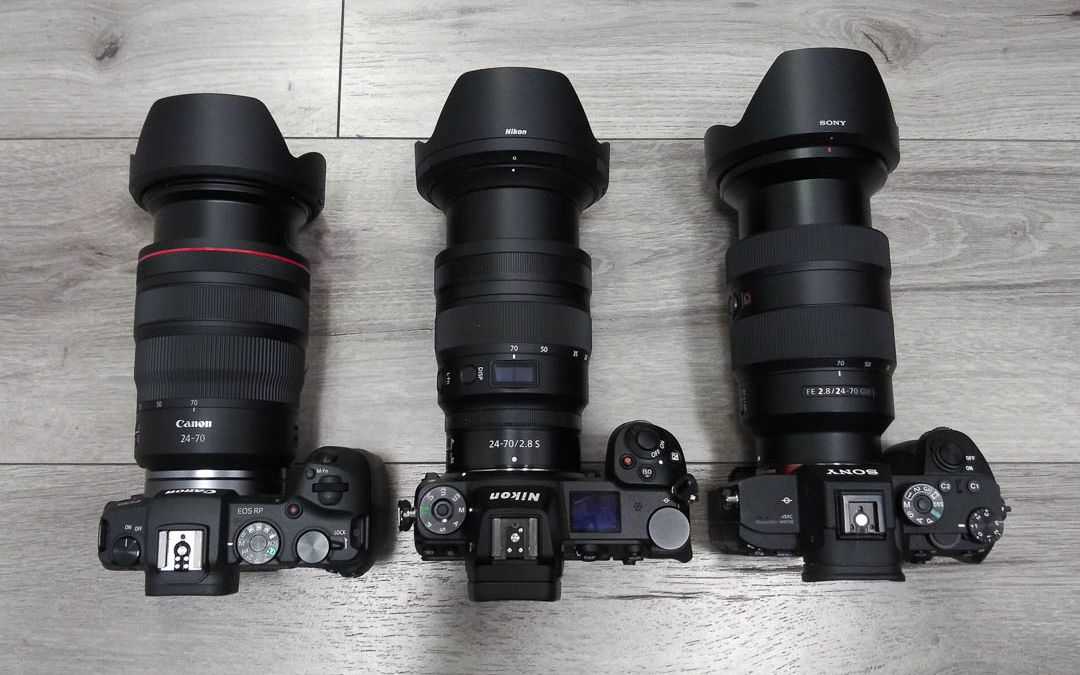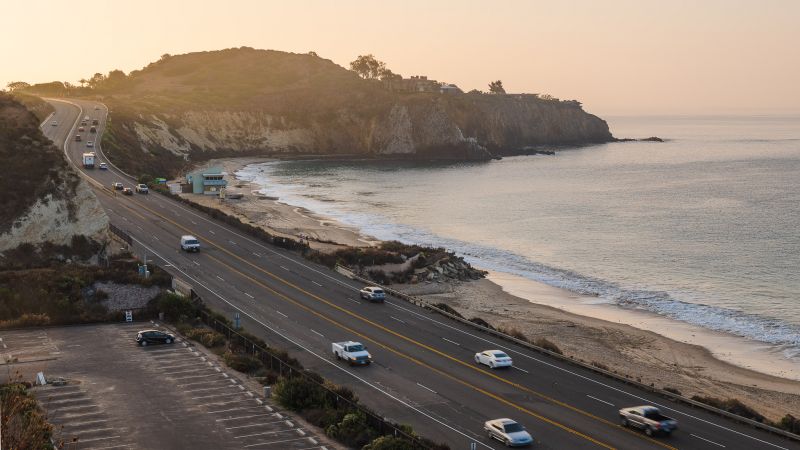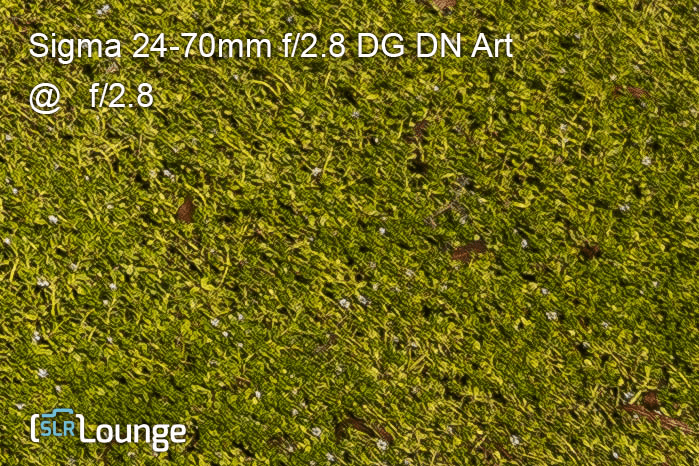
It took years to finally happen, but we now have a complete set of 24-70mm f/2.8 lenses for all full-frame mirrorless camera mounts! In this article, we’ll go in-depth and see how they all compare.
Sony was the first full-frame mirrorless system, of course, with their FE 24-70mm f/2.8 GM, back in 2016. Then, Canon and Nikon followed next with their RF 24-70mm f/2.8 L IS and Z 24-70mm f/2.8 S, at the same time in early 2019. Panasonic followed in mid-2019, with their S Pro 24-70mm f/2.8. Lastly, Sigma’s 24-70mm f/2.8 DG DN Art arrived in late 2019, and we just finished reviewing it after the trying year that 2020 turned out to be.

Is there a clear winner? A clear loser? Not really, to spoil the ending. There are a fair amount of nuances and quirks to each, and as you might imagine, the oldest lens is the least optically impressive, by a small margin, while the newest lenses are all downright incredible.
Of course, the Canon, Nikon, and Sony 24-70mm f/2.8’s are only available for their respective mounts. The Panasonic 24-70mm f/2.8 is only available for the Leica L-mount, however, for that mount, there are Panasonic, Leica, and Sigma full-frame mirrorless bodies available! Last but not least, Sigma’s 24-70mm f/2.8 is available for both the L-mount AND the Sony E-mount.
For the full set of specifications and similarities/differences between these lenses, see the chart below, and then read on to hear about all the significant differences in features or performance for each lens!
Specifications Mirrorless 24-70mm f/2.8 Zoom Lenses
| Canon RF 24-70mm f/2.8 L IS | Nikon Nikkor Z 24-70mm f/2.8 S | Sony FE 24-70mm f/2.8 GM | Sigma 24-70mm f/2.8 DG DN Art | Panasonic Lumix S Pro 24-70mm f/2.8 | |
| Price: | ~$2,300 | ~$2,300 | ~$2,200 | ~$1,100 | ~$2,200 |
| Mirrorless Mount: | Canon RF – full-frame | Nikon Z: full-frame & APS-C | Sony E, full-frame & APS-C | Leica L, Sony E, full-frame & APS-C | Leica L, full-frame |
| Physical Build: | Metal, weather-sealed | Metal, weather-sealed | Metal, weather-sealed | Metal, weather-sealed | Metal, weather-sealed |
| Autofocus | Nano USM stepper motor | Stepper motors | Piezoelectric SSM motor | Stepper motor | Linear + stepper motor |
| Manual Focus | Electronically controlled, distance scale on camera | Electronically controlled, distance & hyperfocal scale on lens LCD & camera | Electronically controlled, distance scale (m/ft) on camera | Electronically controlled, distance scale (m/ft) on camera | Electronically controlled, distance scale (m/ft) on camera |
| Features: | Customizable control ring, AF/MF switch, IS switch | Customizable control ring, AF/MF switch, customizable Fn button | AF/MF switch, customizable Fn button | AF/MF switch, customizable Fn button, Zoom lock switch | Physical manual focus clutch ring |
| Stabilization: | YES (in conjunction with IBIS) | No (IBIS only) | No (IBIS only) | No (IBIS only) | No (IBIS only) |
| Filter Threads: | 82mm | 82mm | 82mm | 82mm | 82mm |
| Magnification: | 0.3x | 0.22x | 0.24x | 0.34x | 0.25x |
| Size: | 3.48 x 4.95 in (88.5 x 125.7 mm) | 3.5 x 4.96 in (89 x 126 mm) | 3.45 x 5.35 in (87.6 x 136 mm) | 3.46 x 4.84 in (87.8 x 122.9 mm) | 3.58 x 5.51 in (90.9 x 140 mm) |
| Weight: | 1.98 lb (900 g) | 28.4 oz (805 g) | 1.95 lb (886 g) | 1.84 lb (835 g) | 2.06 lb (935 g) |
24-70mm f/2.8 Zoom Lens | Who Should Buy It?

First, let’s talk about what types of photography you might want a 24-70mm f/2.8 for! Remember, all of these pro-grade lenses are rather big and heavy; in fact, on average, they’re about the same size and weight as a DSLR lens. And, all but one of them are over $2,000! So, clearly, they’re a serious investment.
Unfortunately, a lot of highly experienced photographers have a love-hate relationship with the entire class of 24-70mm f/2.8 lenses. Why? Because in the past, these lenses were never perfect. The older generations of DSLR 24-70mm’s, in particular, had some serious flaws: they’d be sharp at 24mm but terribly soft at 70mm, or sharp at both ends but horribly soft at ~50mm! You just couldn’t win, it seemed. And none of them were as sharp as a good f/1.4 prime stopped down to f/2.8, of course!
Modern mirrorless 24-70mm’s are all very different from that preconception, thankfully, and are all pretty impressive in terms of their image quality. Honestly, then? They’re now good for a whole lot of types of photography!
The bottom line is that if you are okay with f/2.8 (as opposed to f/1.8, f/1.4, or f/1.2, etc.) and if you don’t mind lugging around a bigger (though not enormous) lens, then you’ll love any of these mirrorless 24-70mm f/2.8’s.
So, maybe you photograph weddings and events, with a lot of action, and/or in low-light. Or, maybe you do portraits of any kind, from high-fashion editorial/commercial work to lifestyle family portraits. Maybe, you photograph landscapes or nightscapes,…the bottom line is, a 24-70mm f/2.8 could be one of your most-used lenses!
Verdict: Which Mirrorless 24-70mm f/2.8 Lens Is The Best?
Alright, let’s dive in and talk about each lens individually, and how it compares to the others. Spoiler alert: As you’ll see from the image samples, each lens is capable of beautiful results. To see a difference between most of the lenses, you’ll have to really pixel-peep, or focus on every subtle nuance of each lens’ “character”.

Canon RF 24-70mm f/2.8 L IS

The Canon RF 24-70mm f/2.8 L IS ($2,299) is unique in that it’s the only mirrorless 24-70mm f/2.8 lens to offer optical stabilization. Yes, most of the other full-frame mirrorless camera bodies do have sensor-based stabilization, and yes, at medium to wide focal lengths, sensor-based stabilization is very adequate.
However, Canon’s lens IS combines with the IBIS of bodies like the EOS R5 and EOS R6 to offer incredibly good stabilization, a minimum of 6 stops, and up to a whopping 8 (yes, EIGHT) stops of total stabilization.
Click here to read our full Canon RF 24-70mm f/2.8 L IS review!
By the way, even on ultralight bodies such as the Canon EOS RP, which lack IBIS, you get 5 stops of stabilization. This is what makes the Canon RF system truly unique, considering how many lenses, both L and non-L, have IS. (There’s the affordable Canon RF 35mm f/1.8 IS Macro ($499) and Canon RF 85mm f/2 IS Macro ($599), to be specific.)
Apart from having IBIS, the Canon also has a customizable command ring, and it’s at the front of the lens, meaning you’re less likely to accidentally bump it than on the Nikon, which puts the “command ring” in the traditional lens aperture position. Nice if you like changing settings that way, but a little too easy to bump in our experience.
Nikon Nikkor Z 24-70mm f/2.8 S

The Nikon full-frame mirrorless 24-70mm f/2.8 ($2,296) is without a doubt the one with the most professional functions, or bells and whistles depending on your needs/standards. It doesn’t have optical stabilization like the Canon, however, it is the only lens with all of the other features:
- Zoom ring, focus ring, and customizable “command” ring
- AF/MF switch
- Customizable “L-Fn” button
- Customizable info display:
- Focal length
- Aperture
- Focus distance
- hyperfocal measurements
If all of these features sound attractive to you, the Nikkor Z lens is not just the only one to offer all of them in one package, but in the case of the information display, it’s the only lens to offer any of those features.
On top of that, the Nikon is, of course, flawlessly sharp, (see extensive image samples in our review here!) and generally one of the best lenses we’ve ever reviewed. Do we wish it also had VR stabilization? A little bit, however, Nikon’s in-body sensor-based stabilization is one of the best around, thanks to the enormous mount diameter that allows for an incredible range of sensor motion. Besides, the lens is already expensive and heavy enough.

Could we find anything to critique about the lens? We get a lot more in-depth with our full review here, but here’s the gist: The only complaint you might have is that it’s a bit “too much”; many serious hobbyists may just not need the info LCD panel, and the control ring in the aperture position is a little too easy to bump accidentally; you might actually just wish for a minimal, no-frills physical design like the Sony with just an Fn button, or the Canon with just a front-end command ring.
Personally? I loved the Nikkor, it gave me a delightful experience as someone who still reminisces of traditional SLR cameras, and as someone who is a serious pixel-peeper too.
Sony FE 24-70mm f/2.8 GM

The original mirrorless 24-70mm f/2.8, the Sony FE 24-70mm f/2.8 GM ($2,198) is a solid workhorse, but it’s also beginning to show its age. (Of course, the lens is only ~4 years old, and serious photographers usually invest in a pro lens like a 24-70mm f/2.8 with the hopes that they’ll get a decade or more of use out of it.)
Unfortunately, though, when pitted against the more recent Canon, Nikon, Sigma, and Panasonic, (with their “Leica-approved” badge) … Sony does the least-impressive job when you start shooting at 42 megapixels, let alone ~60.
The Sony 24-70 is very sharp at 24mm, and throughout most of its zoom range, even wide-open at f/2.8. If you’re not a pixel-peeper and are looking for general event journalism or wedding/portrait lens, it will absolutely get the job done.
However, looking closely at 70mm, and especially in the corners, you’ll see a night-and-day difference between the Sony and its newer competition. The Sony just isn’t as sharp at 70mm, even in the center of the image, until f/4, or f/5.6 in the corners.
Honestly? It’s a good lens, but considering the $2,200 price tag, the Sigma E-mount alternative ($1,100) is our recommendation, hands-down.
Sony might have a “mark 2” version of this lens, one of the oldest in their GM line, coming out soon, but you can bet it will also cost well over $2K. Thus, if you’re at all budget-conscious, just get the Sigma instead.
Sigma 24-70mm f/2.8 DG DN Art

Now, we get to the latest, modern marvel of optical engineering. The Sigma 24-70mm f/2.8 DG DN Art ($1,099) is just the best all-around 24-70mm f/2.8 we have ever tested. (Mind you, we’re not talking about the DG HSM Art lens, which is made for DSLRs!)
Not only is the Sigma mirrorless 24-70mm essentially flawlessly sharp, but it also delivers on the coveted “character” aspects of image quality quite a bit, too, which is something that early Art-class lenses were criticized for not having enough of. Make no mistake, though, the colors and bokeh from this lens are delightful.

Speaking of benefits that not all Sigma Art lenses have offered, the Sigma 24-70mm f/2.8 DG DN Art is also fully weather-sealed and built professionally durable overall, making it a worthwhile long-term investment.
Read our review of the Sigma 24-70mm f/2.8 mirrorless zoom here, for more samples of sharpness, bokeh, and a more in-depth look at the pros and cons of this lens. Most notably, the lens has an AF/MF switch, a customizable “AFL” button, and a zoom lock switch.
Panasonic Lumix S PRO 24-70mm f/2.8

With the prestigious badge of Leica on its flagship S PRO lenses, you’d expect the Panasonic Lumix 24-70mm f/2.8 ($2,197) lens to be an incredible performer, and you’d be right: it is incredibly sharp, basically just as flawless as the Sigma, and it is built like a tank.
The Panasonic has the distinction of being the only lens with a physical, fixed mechanical focus ring, meaning when you slide the clutch back, you see a physical distance scale right there on the lens, instead of it being on the LCD or in the viewfinder. Some folks might actually prefer a focus distance scale in the viewfinder, but for anyone who wants a true linear controlled focus ring, the Panasonic lens, along with its video-oriented bodies, is a professional choice.
Unfortunately, the lens is missing a physical AF/MF switch, which results in you needing to assign a button on the camera body to setting your focus mode.
Image Quality
We’ve extensively tested all five of these lenses, though unfortunately, we weren’t able to get them together all at once for an identical, controlled test.
Suffice it to say that if you look at the extreme corner sample image crop from the Sigma and Panasonic below, you can expect that both the Nikon and the Canon are also similarly “virtually flawless” in terms of not just sharpness, but also the things like aberrations. (See the star sample images below.)







Bottom line: all of these mirrorless 24-70mm f/2.8 lenses, except the Sony, are nearly flawless in terms of sharpness/resolution. And the Sony is no slouch, either; it will certainly get the job done if you’re a photojournalist rocking 24 megapixels and not making enormous prints.
In every other regard, these professional-grade lenses deliver impressive results, whether it is the “pop” of good colors and contrast, or the impressive scarcity of annoying “flare dots”.
Things like bokeh and sunstars, which can’t be “faked” with a lens correction profile, are all quite beautiful from the whole lineup.

Things that can be corrected in a profile, such as distortion and vignetting, are all decently well-corrected, especially when it comes to making sure straight lines stay straight. HOWEVER, we still have a general complaint about ALL of these mirrorless lenses: They could do a better job of correcting vignetting at all focal lengths and apertures. In the case of each of these lenses, if you really over-edit your images with excessive adjustments to the Contrast or Dehaze sliders, you’ll see a vignetting pattern that is impossible to fully correct. This isn’t going to be a problem for most photographers, though; all you need to do is have a little self-control when it comes to going over-the-top with Dehaze etc.
Design & Durability


All of the mirrorless 24-70mm’s are built to flagship professional quality standards. They will stand the test of time, unless you really start abusing them and mistreating them daily, weekly, etc.
They’re all well-protected against the elements with various amounts of weather sealing, and even though they all also extend while zooming, that’s not going to cause any serious issues with water ingestion, and “air suck” issues (that can cause sensor dust) are minimal compared to the telephoto zooms that extend a huge amount when zooming.
Autofocus Performance

All of these lenses have various cutting-edge technology in them when it comes to autofocus. They’re mostly silent, and all are responsive, fast, and precise when it comes to nailing focus and tracking a moving subject.
Of course, when it comes to autofocus performance on mirrorless camera systems, it is the body that plays the biggest role. In this regard, we have to give a nod to the flagship action sports mirrorless camera, the Sony A9 II, which is still ahead of the competition when it comes to tracking subjects with impressive reliability.
This used to be a bigger issue when Canon, Nikon, Sigma and Panasonic all had noticeably inferior autofocus reliability in years past, however, their latest generation cameras have made great strides, and Canon and Nikon’s newest AF systems are more than good enough for almost any challenging condition.
Manual Focus Performance

Like most mirrorless lenses, all of these lenses except the Panasonic have fully electronically controlled manual focus. That used to be a bad thing, many years ago when electronic focus precision was just terrible, but all of these lenses (and the Panasonic) are capable of incredibly fine accuracy, even when trying to nail focus on something as challenging as the stars of a night sky, at f/2.8.
The Panasonic is unique, of course, in that it has a physical focus distance scale and true linear focus control.
Value (Which Lens Should You Actually Buy?)
This one is very simple: All of these lenses are over $2,000, except the Sigma which is just a hair over $1,000, and that makes this a very simple dichotomy: The Sigma is an incredible value, and if you’re on the Sony E-mount or the Sigma/Panasonic/Leica L-mount, you should just get the Sigma.
If you’re on Canon or Nikon full-frame mirrorless? Well, each respective flagship lens has its perks, especially the Canon’s optical stabilization, and the Nikon’s traditional functionality. However, considering the price difference that makes both lenses more than double the price of the Sigma, we have to mention that if you’re at all patient, (maybe you have a DSLR 24-70mm f/2.8 on an adapter?) …then you might want to wait 6-12 months (or a little longer) to see if Sigma can join the Canon RF and/or the Nikon mount with its incredibly good value.
(Don’t get your hopes up, though; we have no rumors, nor insider knowledge, about specific Sigma plans to do anything specific any time soon!)
Mirrorless 24-70mm f/2.8 Comparison | Conclusion

All in all, we only have one clear winner in terms of overall value, and that is, of course, the Sigma. At more than $1,000 less than all of the competition, it is an incredible value, yet its performance is still on par with all of the flagships, or better. Let’s be honest: it trounces the Sony 24-70 GM and makes you wonder if maybe there’s a “II” GM lens in Sony’s near future. (But, again, such a mark two lens will probably cost well over $2K, maybe even $2.5K or higher.)
You should absolutely get one of these 24-70mm f/2.8’s, but only if the type of photography you do really does require the ability to zoom throughout this particular range, AND if you do a lot of low-light work.
If you’re a “prime lover”, and prefer a couple stellar, ultralight f/1.8 primes, or truly high-end f/1.4 or f/1.2 primes, then maybe you should consider an alternative such as the Tamron 28-75mm f/2.8 on Sony’s E-mount, or an adapted DSLR lens for the other mounts.
Should you “jump ship” and switch systems for any of these lenses? Probably not, although the stabilization of the Canon might be very tempting for those who shoot in extremely low light and want the combination of both IBIS and IS.
Also, the Nikon is a delight to use for those who still remember the SLR days, with focus distances and hyperfocal markings available on a lens, plus a customizable command ring and Fn button; no other lens has this many additional features and customizations.
The only lens that is lagging behind the rest of the pack is the Sony GM, but then again, the most “desirable” lens is the Sigma, so it balances out the Sony E-mount in terms of desirability. If anything, considering that we have no idea when Sigma will be able to make lenses for RF or Z mounts, and considering that Sony’s A9-series still is leading the pack in terms of autofocus, the Sigma plus a Sony 9-series make the most compelling case to buy into the Sony system overall, whether it’s the first full-frame interchangeable-lens camera system, or it’s a “big jump” from another brand.
At the end of the day, we were delightfully surprised to find that all of these lenses were impressive performers, even though we were a bit disappointed at first when full-frame mirrorless flagship lenses didn’t turn out to be that much smaller, lighter, or cheaper than their DSLR predecessors.
If you have any questions, please feel free to leave a comment below!
Check Pricing & Availability
Canon RF 24-70mm f/2.8 L IS ($2,299) – Adorama | B&H | Amazon
Nikon full-frame mirrorless 24-70mm f/2.8 ($2,296) – Adorama | B&H | Amazon
Sony full-frame mirrorless FE 24-70mm f/2.8 GM ($2,198) – Adorama | B&H | Amazon
Sigma 24-70mm f/2.8 DG DN Art ($1,099) – Adorama | B&H | Amazon
Panasonic Lumix 24-70mm f/2.8 ($2,197) – Adorama | B&H | Amazon
Matthew Saville
Follow his wilderness nightscape adventures on Instagram: instagram.com/astrolandscapes




Get Connected!